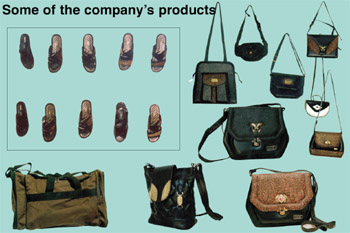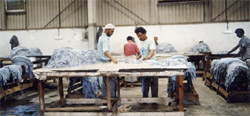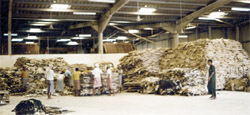
SHAMMAKH TANNING & LEATHER IND. CO. LTD [Archives:2001/18/Business & Economy]
April 30 2001

The idea of expanding the business of the Shammakh Trade House to include leather industries started 40 years ago. The project was to start using local raw material to participate in the development of the country’s economy and help in producing new industrial goods using the products of the tannery. This was intended to create a trade balance between the imports and exports and provide Yemen with income in hard currency.
Current Products
The factory’s current products are:
Pickled / Wetblue / Crust Sheepskins and Goatskins
Pickled / WetBlue Calfskins and Cattle Hides
Vegetable Tanned Goatskins, Sheepskins and Hides

The invested capital in this particular company exceeded YR 900 million. It employs about 350 Yemeni employees. The production capacity is around 10,000 pieces of sheep skin daily. Currently it works with 70% of its maximum capacity. The cattle hide tanning line has the installed capacity of producing 300 pieces of cattle skin daily but it is currently not operational because of the lack of raw material. These hides are usually exported to Syria and Saudi Arabia as raw products.
Exports
The exports of the company constitutes 85% to 90% of its production amounting to a total ranging from US $ 5.5 to 7.0 million annually. The production can be tripled if more attention is given to the livestock resources and if female and young livestock animals are not slaughtered carelessly. The media awareness and training of butchers in using right methods of flaying the skin without damaging it is also of great importance.
The company’s products are exported mainly to Italy, UK, India, Malaysia, Indonesia, Czech Republic, Poland, and Spain.

As many other factories all over the country, we suffer from the instability in the economic situation. We also suffer from:
1- Neglect of the authorities concerned in terms of spreading awareness to citizens to preserve the livestock resources and take care of them. This can be done through TV and other media organs and also by giving a larger role to the slaughterhouse establishment, ministry of agriculture in this prospect.
2- Forbidding of the export of raw skin. Export of skins leather should be permitted so as to encourage investors to start their businesses in the field of tanning and development of leather industries.
3- Current investment laws do not take into consideration the specialty of such industries. They are equated with entertainment projects.
4- Difficulty in dealing with the law of recovering raw material fees used during exports.
5- High indirect costs of production, such as fuel, transportation, electricity, medicine, etc.
6- Official and nonofficial smuggling, which resulted in the closure of many factories, threatening to close our shoe producing factories. Instead of getting the attention to our problems, we realize that we only receive more taxation apparently as a result of the authorities’ stubbornness and conspiracy.
7- Due to the lack of specialized institutions in the field of leather industries in the Arab world, we find it very difficult to improve our human resources technically. We cannot send our employees abroad because of the language barrier.

1- The company is contributing in building schools, mosques, medical center, and water projects for the neighboring villages.
2- It participates in training the local workforce as there are no institutes or training centers for this particular industry, neither locally and nor regionally.
3- It participates in developing and encouraging traditional handcraft productions by providing what is needed of leather with competitive prices that do not exceed 75% of the cost of production, implying 25% loss for the company for this material.
4- It participates in providing the artificial limbs and natural medication center in Sana’a with its needs in leather according to available raw material and with costs that do not exceed 60% of the cost of production.
Future Plans
The factory has several plans to start derivative industries from the leather industry such as the gelatin production factory if the appropriate conditions exist. The feasibility study is still being done. The expected cost of establishing this factory is around USD 4 million.
There are also plans to develop leather tanning to advanced stages as we have indeed obtained investment permission to do so. The production based on this development, may with God’s will, start soon.
Present and Future of the Leather Industry in Yemen
About the present and future of the leather industry in Yemen, Mr. Ahmed Shammakh said, “The leather industry in Yemen is currently suffering severely from the low quality material and competition of neighboring countries that import the raw material from Yemen for use in their highly advanced factories.
This results in a low capacity and quality production of leather factories in Yemen. This competition results in less profit from leather manufacturing in Yemen, preventing further investment and development of the available factories.
Despite all that, the future of leather industry is promising if efforts are to be exerted to develop this important industrial sector, especially because it does not require qualified labor and uses more employment.
This is quite suitable for Yemen if little training is given to its available workforce. However, if the slaughtering of female and young livestock continues, the future may become uncertain because the number of livestock is dropping dramatically.
Due to want of statistics, our estimate is that the number of livestock has dropped around 25% of what it used to be 10 years ago, and the number is still declining.
Ahmed Shammakh

Mr. Ahmed Shammakh started the first industrial line of the company by establishing the factory of leather, shoes, and other leather goods. He is currently the chairman of the Industrial Committee of the Hodeidah Chamber of Commerce and Industry. Besides that, he is also the chairman of the Local Council for Vocational and Technical Education and Training in Hodeidah. Shammakh is also a prominent member of the International Leather Chamber and the Chairman of the SMS group in Malaysia and Singapore.
——
[archive-e:18-v:2001-y:2001-d:2001-04-30-p:./2001/iss18/b&e.htm]


